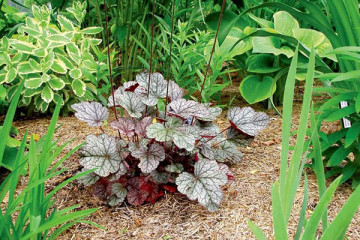Marigold flowers - planting and care in the open field
Content:
The most common annual flowering plant that adorns gardens and flower beds in central Russia, in the south and even in the northern regions are marigolds, also called tagetes. They have a rich palette of colors, healing properties and exceptional unpretentiousness to growing conditions.
What marigold flowers look like
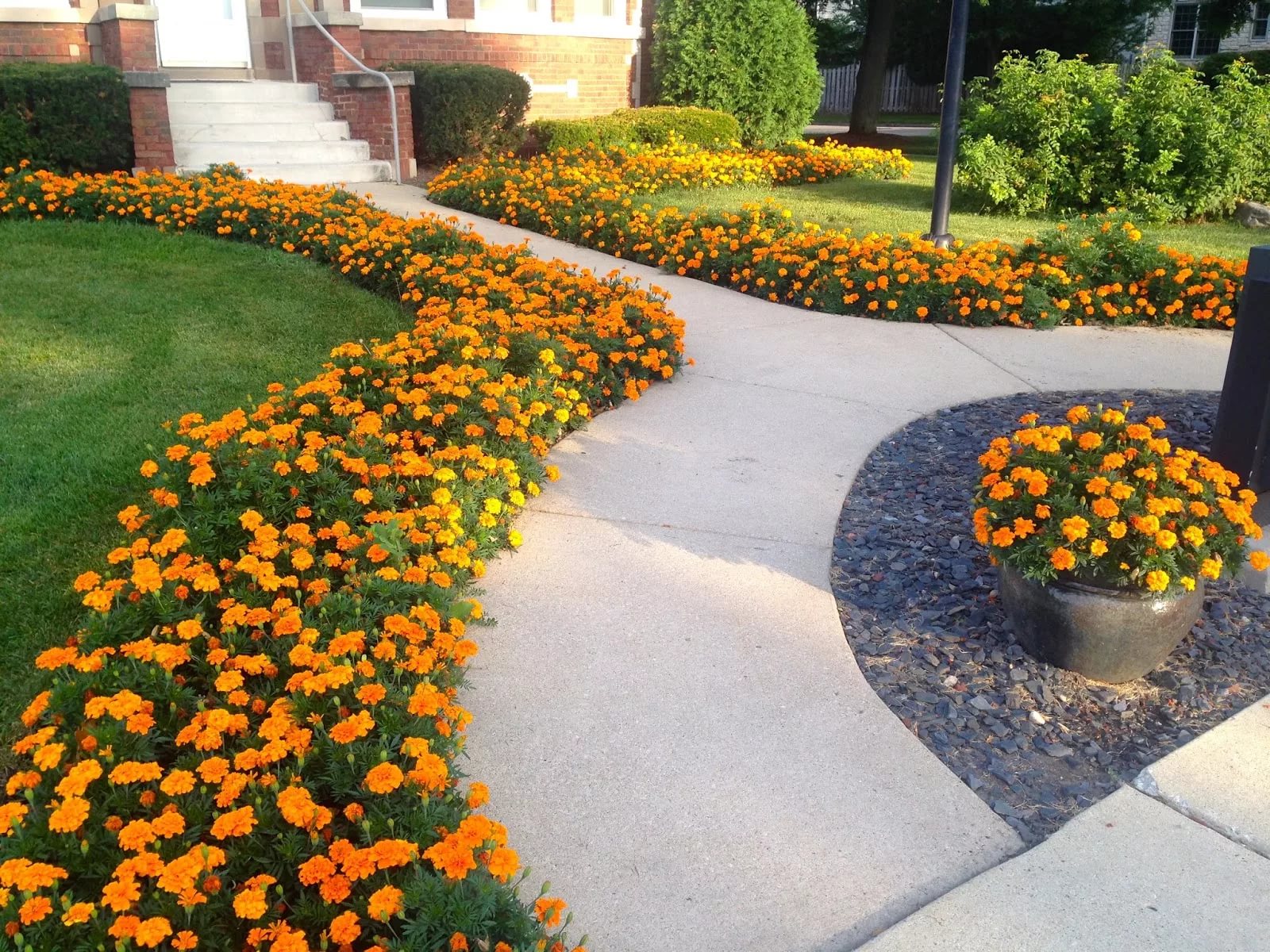
A path decorated with a strip of marigolds
The plant is a highly branched stem with dissected dark green leaves, from the axils of the shoots of which numerous buds are formed.
The flower is a simple or double basket with a bright characteristic aroma and yellow, orange, brown petals. There are also red ones, for example, the marigold variety - Carmen, but never purple.
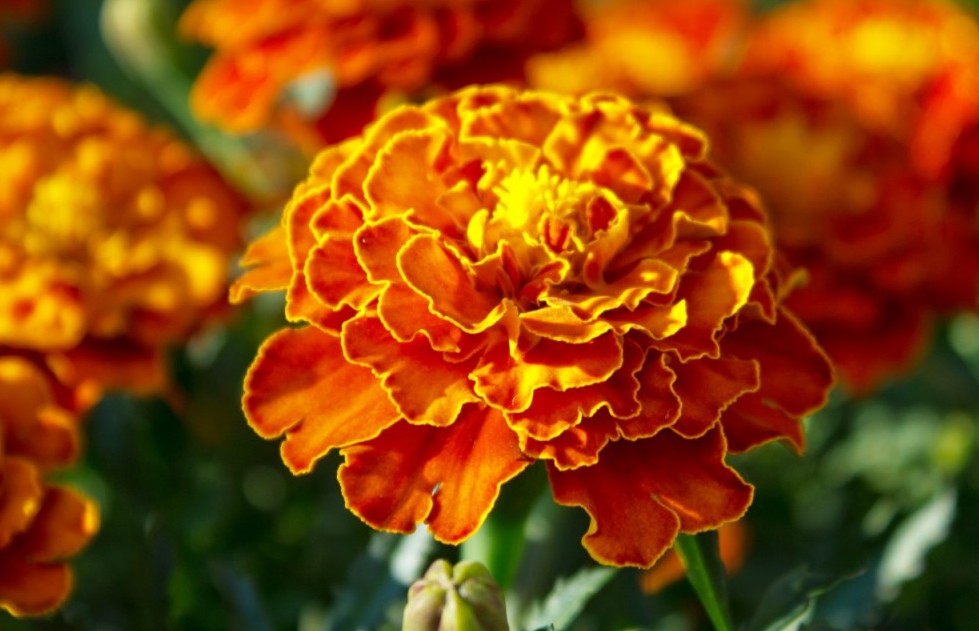
Characteristic flower shape
What family does it belong to
Tagetes (lat. Tagetes) belong to the family Asteraceae (Latin Asteraceae) or Compositae (Latin Compositae). In the gardens today, hybrids are grown, bred by breeders from wild forms, and now growing in Central and South America.
Briefly about the history of appearance
The plant was exported from America in the 16th century by conquistadors. It quickly gained popularity for its exceptional unpretentiousness, thanks to which it spread throughout Europe, and later became a favorite culture in gardens in Russia and Asia.
Plant characteristics

A single bush of a dwarf variety with blossoming flowers and buds
The root of marigolds is pivotal with a lobe of thin roots, lying at a shallow depth and serving as a support for the heavy aboveground part. Stem - erect, highly branched.
Usually dark green leaves have a pinnately dissected shape, but occasionally they are whole.
- Each inflorescence is a basket from 1 to 6 cm in diameter, which can be double or simple.
- They usually bloom from June to the first frost.
- Seeds ripen all summer, their germination is not lost until 4 years.
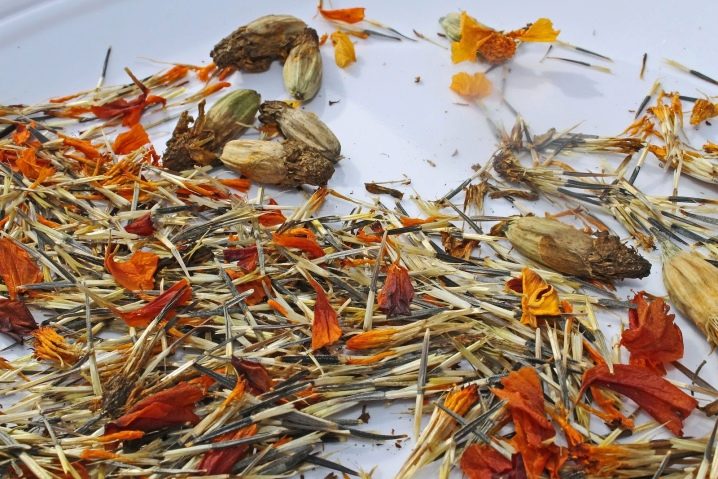
This is what the seeds look like
Classification of marigold species
In horticultural culture, three types of varieties are most common. Each type was bred by breeders for a specific purpose, but there are no fundamental differences between these groups in terms of growing conditions.
- Erect (Tagetes erecta), or African
Various varieties of this group can be dwarf (up to 20 cm tall) and tall - up to 60-80 cm and even higher.
The buds grow on pedicels up to 10 cm long. The flower is usually large (3-6 cm in diameter), it can be simple and double. Erect marigolds are well suited for landscaping urban areas.
- Stunted, or rejected, or French (Tagetes patula)
Small-flowered low-growing annuals 15-50 cm high. Numerous shoots strongly deviated to the sides extend from the stem, resulting in a spherical crown.
This type is distinguished by its vitality: it is not afraid of air pollution, drought, and even recurrent spring frosts. Rejected marigolds are suitable for cultivation in open ground and in containers, pots.
- Thin-leaved, or Mexican
The most common group, the most hardy and unpretentious, easily reproduces by self-seeding.
Fine-leaved marigolds have a flower often of a simple shape, occasionally semi-double, only 1-3 cm across. Color - from almost red to pale yellow petals, there are also varieties with brown, ocher, terracotta flowers.

Almost red Mexican variety
The cultivars that are most popular with horticulturists
Today, you can buy planting material at a regular garden kiosk or in an online store, and sellers will offer more than three hundred varieties of all kinds of sizes and colors to choose from. In this variety, the following varieties are most popular.
- Antigua
The variety series includes several variations in the color of double flowers: yellow, orange, lemon-yellow. The height of an erect, beautiful plant does not exceed 30 cm.
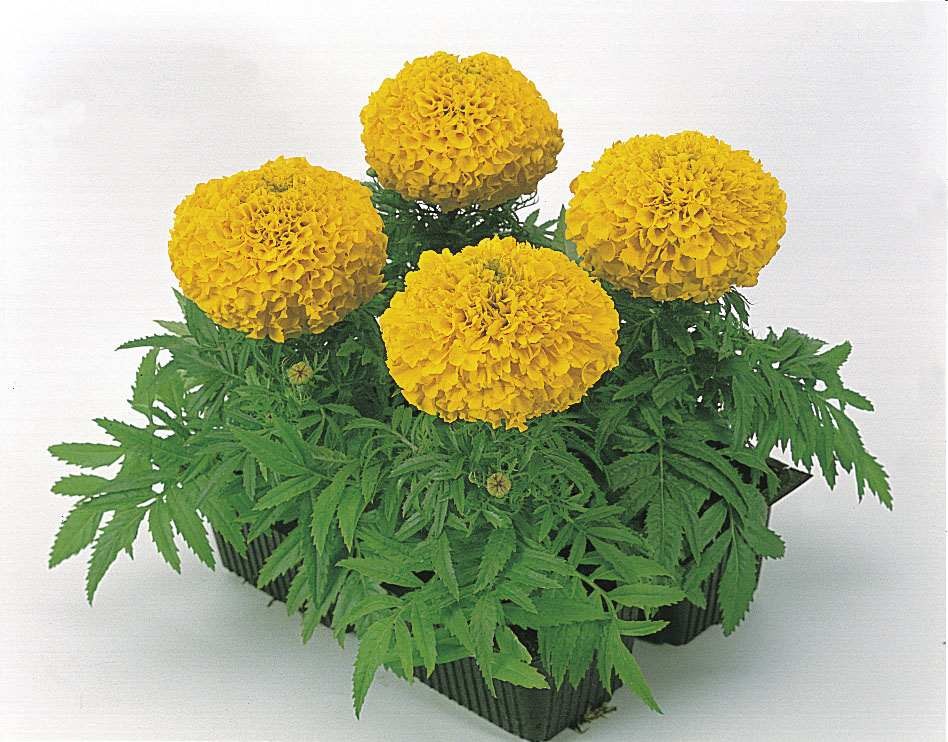
Antigua Yellow marigolds
- Hawaii
An erect, tall bush variety up to 90 cm high. The color of carnation double flowers, similar to bright pompons, usually yellow or orange, up to 10 cm in diameter. Suitable for commercial cutting.

Hawaii - orange petals
- Gold Dollar
An upright variety from among the early ones with large, tall bushes up to 1 m high, used to decorate the central part of the flower bed. Carnation flowers have a red-orange color of the marginal petals and a yellow core.
Feature: almost no smell.

Gold dollar
- Kilimanjaro
A hybrid with a white (cream) flower color and a slightly darker core. The diameter of the corolla reaches 12 cm.The total height of the bush is up to 70 cm.
The foliage is very lush and looks especially elegant against the background of light buds.

White marigolds - Kilimanjaro variety in full dissolution
- Glitters
The second name is Shine. Tall erect bushes up to 100-115 cm high are covered with yellow-orange flowers about 12 cm in diameter.

Glitters tagetes
- Goldlicht
This tall variety differs from others in its late flowering and unusual shoots, which have a tetrahedral cut and a red-brown color.
Clove-shaped inflorescences of medium size - terry, painted in a rich orange hue.

Goldlicht Tagetes
- Friels
A sprawling compact bush stretches up to 80 cm in height. The flower is large, up to 10 cm in diameter. The color is golden-orange.
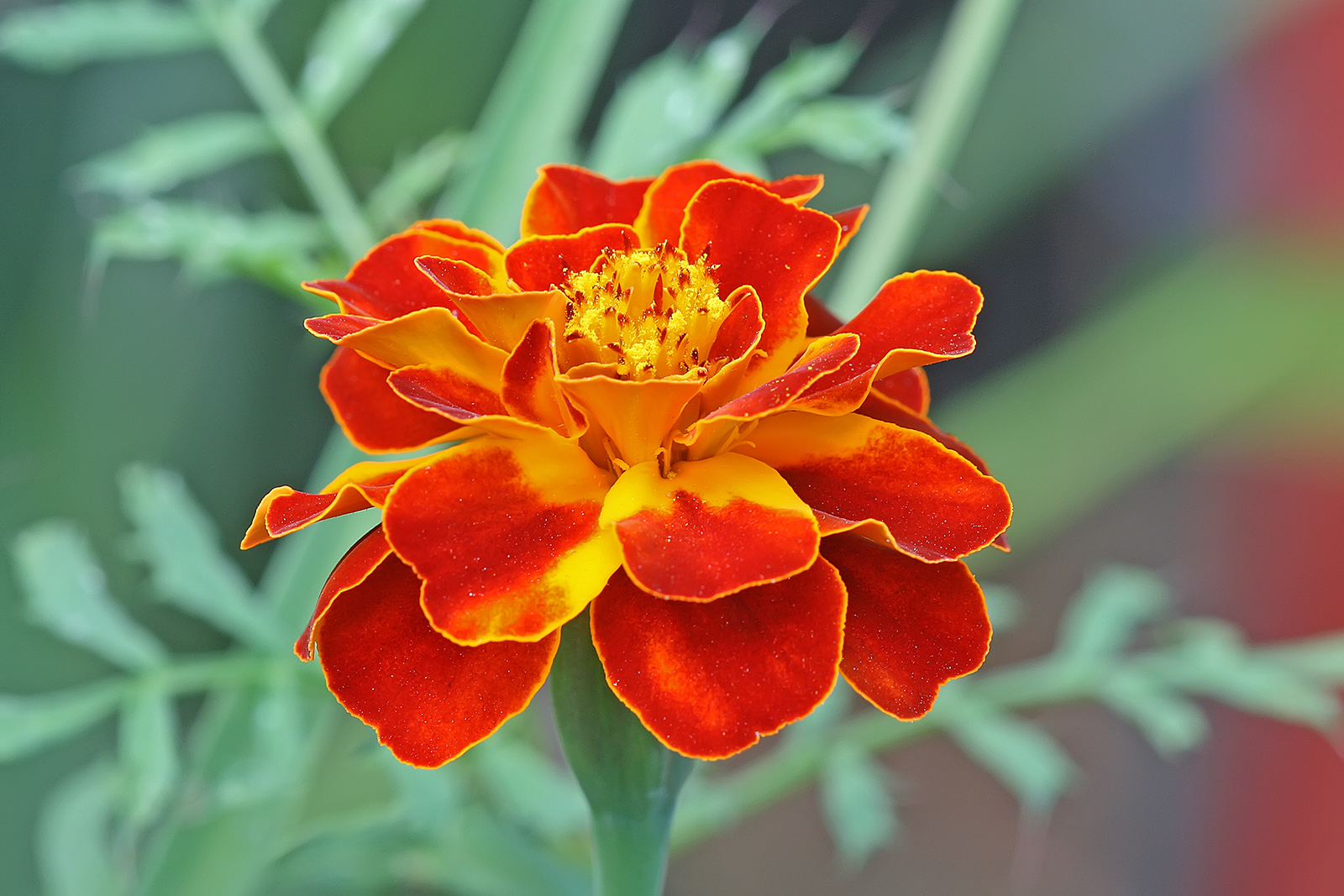
Freelz variety
- Bolero
Dwarf rejected tagetes with a height of only 15-20 cm blooms with a yellow-red tint.
The variety is one of the most common, as it blooms just 1.5 months after germination and is not afraid of partial shade.

Bolero Flower
- Naughty Marietta
A compact variety up to 40 cm high. The flower is two-colored, simple, yellow-ocher, blooms on a long (10-12 cm) pedicel.

Naughty Marietta
- Bonanza
Border variety with a height of 20-25 cm. Flowers of a dense orange hue are simple, up to 5-6 cm in diameter.

Bonanza marigolds
- Gold Ball
Medium-sized bushes 50-60 cm high bloom in baskets up to 4-5 cm in diameter. The color of the petals according to the description is golden yellow with a greenish center.

Gold ball
- Jolly Jester
Rejected marigolds with flowers painted in two colors at once: half of the petals are yellow, half are red-brown. Plant height - 65 cm.

Tagetes Jolly Jester
- Red Gem
The compact bush is distinguished by strong branching of the stems, the total height is 25-30 cm. The leaves are dark green, and the simple flowers (5-6 petals each) are of a rich red-brown color with a yellow core.

Variety Red Gem
- Lemon Jam
Thin-leaved tagetes up to 30 cm high with light green lace foliage and rich lemon shade of flowers. Corollas are simple, usually containing 5 petals.

Lemon Jam
- Mimimix
Compact upright bush up to 50 cm high with feathery rich green leaves. The flowers are simple, small (up to 2 cm in diameter), with a pleasant aroma and different colors: orange, yellow and bright red.

Multicolored meadow Mimimix
- Golden Ring
Thin-leaved variety with high fragility of stems and leaves. Plant height - up to 50 cm.
The flower is usually no more than 3 cm in diameter, with a golden hue.

Marigolds yellow Golden Ring
- Gnome
Border variety up to 25 cm high with a spherical crown and openwork dark green foliage. Refers to very early. A simple flower has an orange-yellow large convex core and ocher petals with wavy edges along the edge of the basket.

Low-growing marigolds Dwarf
How marigolds reproduce
The plant propagates easily by seeds. You can try planting with cuttings taken from an adult plant in the lower part of the crown, but this method is limited.
Sowing can be carried out on seedlings and directly into open ground. In both cases, the result is excellent. But the seedling method allows you to get flowering plants in flower beds after the May holidays, which is why they use it.
Sowing seedlings is carried out in early March. Usually 2-3 seeds are sown in pots. Sowing in open ground can be carried out in early May.
For seedlings, take cups of 100-150 ml. You can sow in long containers, then take containers 15 cm high or slightly higher.
The soil for planting marigolds is universal with a pH = 5.5-6.5. For better aeration, it is recommended to add a little clean sand (no more than 20% by volume) or vermiculite to it.
Seedlings need bright sunlight (or backlighting for at least 6 hours a day), regular watering and an air temperature of about + 18-24 ° С.
The first time you can feed the seedlings 2 weeks after the emergence of seedlings with a solution of complex mineral fertilizer.
Seedlings usually appear a week after sowing. Diving is carried out at the stage of 3-4 true leaves in individual pots from a common box.
Seedlings are planted in open ground when night temperatures rise above +5 ° C. A distance of at least 40-50 cm (for tall varieties), or 15-20 cm (for curbs) is left between individual plants.
Marigolds - growing by a seedless method
Sowing in open ground is carried out to a depth of not more than 1 cm. Between the holes or rows, leave a distance equal to half the height of the selected variety. When stable warm weather is established, seedlings will appear in a week. In the future, care will consist in watering and applying top dressing.
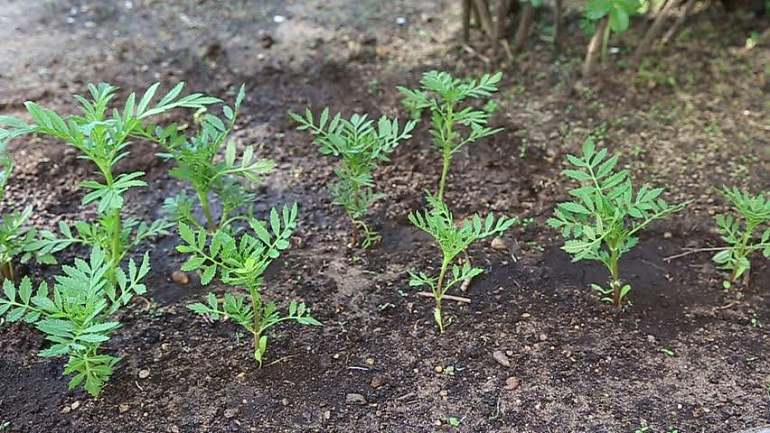
Seedlings of marigolds
Features of care in the garden
Perennial or annual marigolds are planted everywhere: in parks, squares, gardens, in flower beds. Can be grown on a window in a pot, or on a balcony in a hanging planter. But best of all, this flower feels in an open sunny space.
Tagetes need a lot of sun, air temperature in the range of + 15-35 ° С, as well as loose fertile soil. In partial shade, flowering will become less abundant.
The plant tolerates a short drought. But it can die with prolonged night frosts, and prolonged waterlogging leads to decay of the roots.
Flowerbeds can be watered 1-2 times a week, even during the hottest season. In order for the flowers to bloom regularly and delight them with splendor, it is important to provide regular feeding.
To avoid too frequent watering, cracking of the soil, and weed growth, mulching the soil around the flowers helps. Chopped grass, sawdust and fallen leaves will do.
The root system of the culture is superficial, so the soil is loosened to a depth of no more than 5 cm. You can do without it if you mulch the soil.
During the entire time after planting seedlings or emergence of seedlings, feeding is carried out at a frequency of 1 time in 2 weeks. Usually, complex mineral fertilizers alternate with organic ones, but you can do with mineral fertilizers alone.
Superphosphate application rate: 40 g per 1 m2.
Transfer
If necessary, the bush can be transplanted. To do this, it is dug out with a lump of soil and transferred to a new place. Water immediately abundantly. If it turns out in the process not to damage the roots, then in a new place the flower will quickly start growing.
When and how it blooms
The first flowering in early varieties occurs at the age of 1.5 months, and in late varieties at the age of 2-3 months from the emergence of shoots.
Types of flowers
The most common are three types:
- simple - small-colored with one row of long petals along the edge of the basket;
- semi-double - have several rows of long petals around the perimeter of the inflorescence;
- terry - large-flowered, numerous petals form a large spherical inflorescence.

Semi-double inflorescences
Flower shapes
Along with the usual types of inflorescences, the newest varieties of Tagetes have others.
Today you can admire the chrysanthemum and carnation specimens.

Chrysanthemum variety Lunasi
Flowering period
When marigolds bloom, depends on the variety.
- Early varieties planted with seedlings will bloom in May or early June.
- The later ones will bloom in early or mid-July.
- Flowering usually ends only with the onset of frost.
Changes in care during flowering
Since flowering is a large part of the active growth time, how to care for marigolds during this period depends on the particular cultivar.
The tall ones need more fertilizers and watering more often, and the curb ones need to apply the minimum dosage of fertilizing together with watering, but at least 2 times a month.
Possible growing problems
Marigolds rarely give gardeners special trouble. But sometimes, under adverse conditions, they can be affected by pests or diseases.
Pests
Whiteflies, snails, slugs and spider mites do great harm to tagetes. For snails and slugs, specialized drugs are used, as well as for whiteflies. Spider mites are destroyed by spraying with acaricides.
Diseases
Most often, when flooding with simultaneous hypothermia, the flowers suffer from a fungal disease - a black leg. As a treatment, the affected specimens are removed, or the damaged parts of the plants are excised, and then the planting is sprayed with a solution of potassium permanganate.
Signs of improper care
In home gardens, the lack of flowers is the first symptom of mistakes in caring for marigolds. This happens with too long drought, excessive watering, lack of nutrients in the soil. It is necessary to adjust the watering and make a planned feeding.
Use in landscape design
Marigolds on the balcony are a bright and spectacular decoration; for this, border or dwarf varieties are planted. They are also usually used for framing tracks.
Tall varieties with large double flowers are planted in the central parts of the flower beds. Marigolds in tubs and flowerpots look very beautiful.
It has long been noticed: once you plant marigolds on a flower bed, interest in the diverse varieties of this amazing plant will only grow stronger. The benefits from them are very great, since they are not only very beautiful, but also scare away pests from other flowers, and also contribute to the health of the soil.


